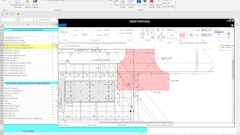
As tool technology continues to advance, the price of items such as concrete drills, cutoff saws and other powered hand tools found on construction projects tends to grow along with it. So, each time a tool disappears or is misplaced, it’s a further expense to replace it. A tool here, a tool there — the costs can add up to a lot during the course of a project or over an extended period of time.
To combat such cost creep on its construction projects, Ohio-based Barton Malow is testing available technology to see how it can help improve management of tool tracking and logistics and potentially save on tool costs long term.
Barton Malow's Matt Hedke and Ryan Tow sat down with Equipment Today Editor Becky Schultz to discuss tool tracking on the jobsite. Listen to the podcast here.
Many, Many Items to Track
Barton Malow has been in business for nearly 100 years and has 15 offices throughout the East Coast, with projects scattered across the country. Employing more than 2,000 workers, it operates in the commercial, institutional, industrial, energy and manufacturing sectors, as well as self-performs civil operations, concrete — including walls, foundations and flatwork — rigging, structural steel, interiors, refractory, boilermaker and other work.
“One of the things that we pride ourselves on is that diverse market,” says Matt Hedke, director of virtual design and construction. “We try to have a pretty equal portfolio. Operating in all those different markets gives us flexibility. We don’t want to have too much work in one specific area.”
Working on projects throughout the U.S. means equipment and tools are distributed to several disparate locations at any one time. Tracking those resources is a primary challenge, according to Ryan Tow, operations manager. Tow oversees the equipment yard in Oak Park, MI, which supports all of the self-performed trades.
Nearly all the equipment, tools and accessories Barton Malow requires on projects are moved in and out of yard operations, so each item must be carefully tracked and managed. This adds up to a lot of individual items.
“All of the [concrete] accessories, all the panels... are tracked and managed and rented out of our yard operations,” Tow notes. “Some of the things that are the most challenging, I would say, are a lot of the smaller items that we have where there tends to be a huge inventory. Formwork is one of them... because we have multiple formwork systems and there are a lot of accessories that go along with them.
“Being able to track and manage those from project to project and at the same time keep our inventory up to our standard, and then be able to redeploy to the next job — there’s a lot of stuff that goes on behind the scenes,” he comments.
 The ability to capture data on how a tool is being used and how it's performing on a project can provide useful insights that can be used to enhance both tool and operator productivity.Milwaukee Tool
The ability to capture data on how a tool is being used and how it's performing on a project can provide useful insights that can be used to enhance both tool and operator productivity.Milwaukee Tool
Barton Malow uses a sizable number of small tools. If they go missing, costs mount. “Everybody knows the price of everything just keeps climbing and climbing,” Tow says. “It was a $60 drill. Now, it’s a several hundred-dollar drill and then you have a $150 battery, two or three of them. So, you have a good amount of capital tied up into a cordless power drill.
“We’ll walk away from a year-to-year job and there’s a huge dent. There’s a lot of missing stuff on certain projects, especially the further out we get where they’re not our ‘regular’ staff,” he notes. For example, laborers brought on for these jobs may not fully understand the company’s processes, there may be theft, tools may be picked up by other contractors, etc. “There’s a bunch of different scenarios, so we have more issues on that end.”
“As we get further and further away from that centralized hub, a lot of those things get more complex and harder to manage,” says Hedke. “There are all these moving parts that, over time, we have evaluated and refined. And we continue to try to figure out how do we leverage technology to help drive that process and educate not only our own people on our projects but our trade partners, as well.”
Tool Management, Cost Control and More
 Milwaukee Tool's Tick is a BlueTooth tracking device that provides location updates when a tool comes within 100 ft. of a mobile device that has the One-Key app installed.Milwaukee Tool
Milwaukee Tool's Tick is a BlueTooth tracking device that provides location updates when a tool comes within 100 ft. of a mobile device that has the One-Key app installed.Milwaukee Tool
A more recent addition has been Milwaukee Tool’s Tick, a Bluetooth tracking device that provides location updates when the tool comes within 100 ft. of a phone that has the One-Key app installed. “We use it on our small power tools — SDS-plus hammer drills, 1/4-in. impacts, 1/2-in. drill drivers,” says Tow. “There’s an assortment of smaller cordless power tools that we have those on.”
The potential advantages in logistics management have proven readily apparent. In the past, when a tool couldn’t be found on the jobsite, the crew would simply order a new one. With tool tracking, that’s no longer necessary.
“You have the capability to be able to say, ‘All right, I know I [had] a tool that was here this morning,’ and then be able to pull up some software, look on a map and know it’s over in the southeast corner [of the jobsite],” Tow explains. “When you can say, ‘Let’s go get it’ instead of having to buy another one, you’re saving resources and capital.”
Also offering significant advantage is the ability to create geofences. “From a theft perspective, by creating that geofenced perimeter, that tool shuts off if it leaves or you get a notification that it’s left [the specified area],” Hedke says. “Those are all things that I think we, as an industry, can see huge benefits in.”
The ability to capture data on how a tool is being used and how it’s performing on the project offers benefits, as well. “From my perspective, Milwaukee Tool and others started to look at opportunities to get data out of their tools,” says Hedke. “That [opened the door] for us to... try to figure out, ‘How do we make that connection between the user and that data and learn from that data? How can we start to look at the data holistically and use it as a way to learn and get insights on tool utilization?’”
“If a grinder pulls, if the brake e-clutch is engaging — the same with the hammer drill — being able to pull those analytics off for safety and being able to train your staff is a benefit,” Tow agrees. “Some people aren’t necessarily going to be trained correctly in how to use power tools from a safety standpoint, so you can use that information.”
The data could also be used to assess the type and number of tools that will be needed to complete a project or task. “Tools have a useful life. You can figure out how many tools you’re going to need by how many dowel holes you’re going to be drilling, or whatever it might be,” says Tow. “A lot of it is just to be able to get that information off of that tool and use it in a productive manner.”
Learning Through Partnerships
Setting the stage to maximize the overall benefits of tool tracking technology is an ongoing process for Barton Malow, involving input from multiple sources.
“The only way that we’re going to learn is if we get plugged into it and we start to identify and partner with the tool manufacturers and partner with our project teams to set up a roadmap to say ‘Here’s our basis for a pilot and here’s some low-hanging fruit that we think we can get. If we can achieve that first step in just capturing this data, here’s some benefits that we see,’” Hedke comments. “And I think, organically, you’re just going to learn that there are other benefits that maybe we’re not yet seeing.”
 DeWalt just recently introduced the Tool Connect Construction Asset Gateway, which can be deployed in jobsite boxes, vehicles, and tool cribs to automatically audit inventory and provide total jobsite visibility in its Site Manager platform.DeWalt
DeWalt just recently introduced the Tool Connect Construction Asset Gateway, which can be deployed in jobsite boxes, vehicles, and tool cribs to automatically audit inventory and provide total jobsite visibility in its Site Manager platform.DeWalt
There’s also the matter of whether data can reach where it needs to be. “When you start to have... all these smart tools out in the field, there’s certainly a jobsite connectivity concern,” says Hedke. “I think that’s an industry-wide problem.”
Then there’s the issue, and opportunity, with software integration. “There are a lot of different project management solutions out there,” says Hedke. “We’re a big Autodesk user; we use BIM360. [We’re learning] how we get that data and that tool tracking technology integrated into our project management solution. That’s another opportunity that we’ve been having a lot of discussions with the folks at Milwaukee Tool about.
“Again, it just brings up a lot of really, really cool opportunities that we’re excited about that we want to be a part of coming up with a solution for, and certainly looking to partnerships with Milwaukee and others to try to solve them,” he continues. “I think the technology is going to allow us to really open the door for how we track and manage our tools, use the data we get from them and integrate it with other solutions.”
Still, there is value in taking a measured approach. “There’s an endless amount of data that it can probably be overwhelming if we’re not careful,” Hedke acknowledges. “But I think if we’re smart, we can start to use it in a smart way and learn from it and better ourselves for years to come.”






























